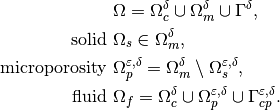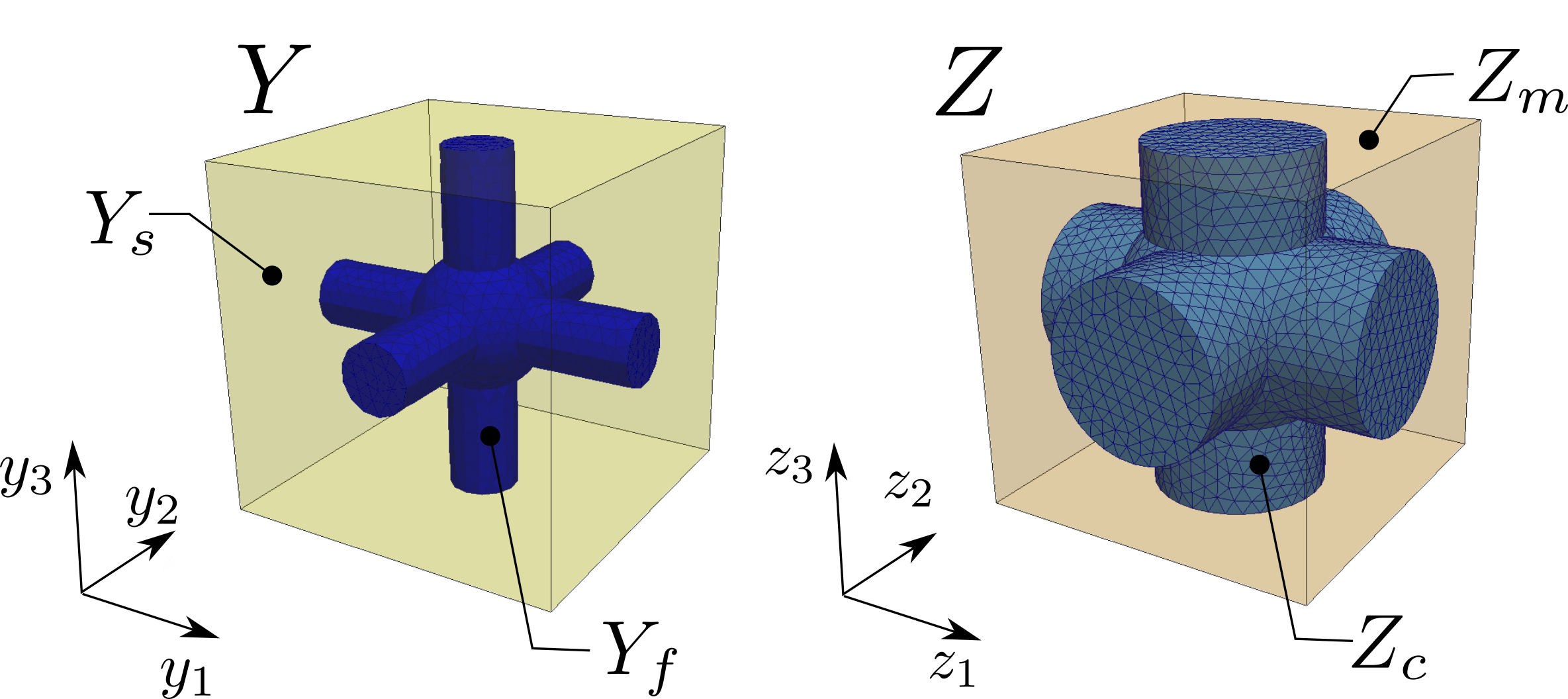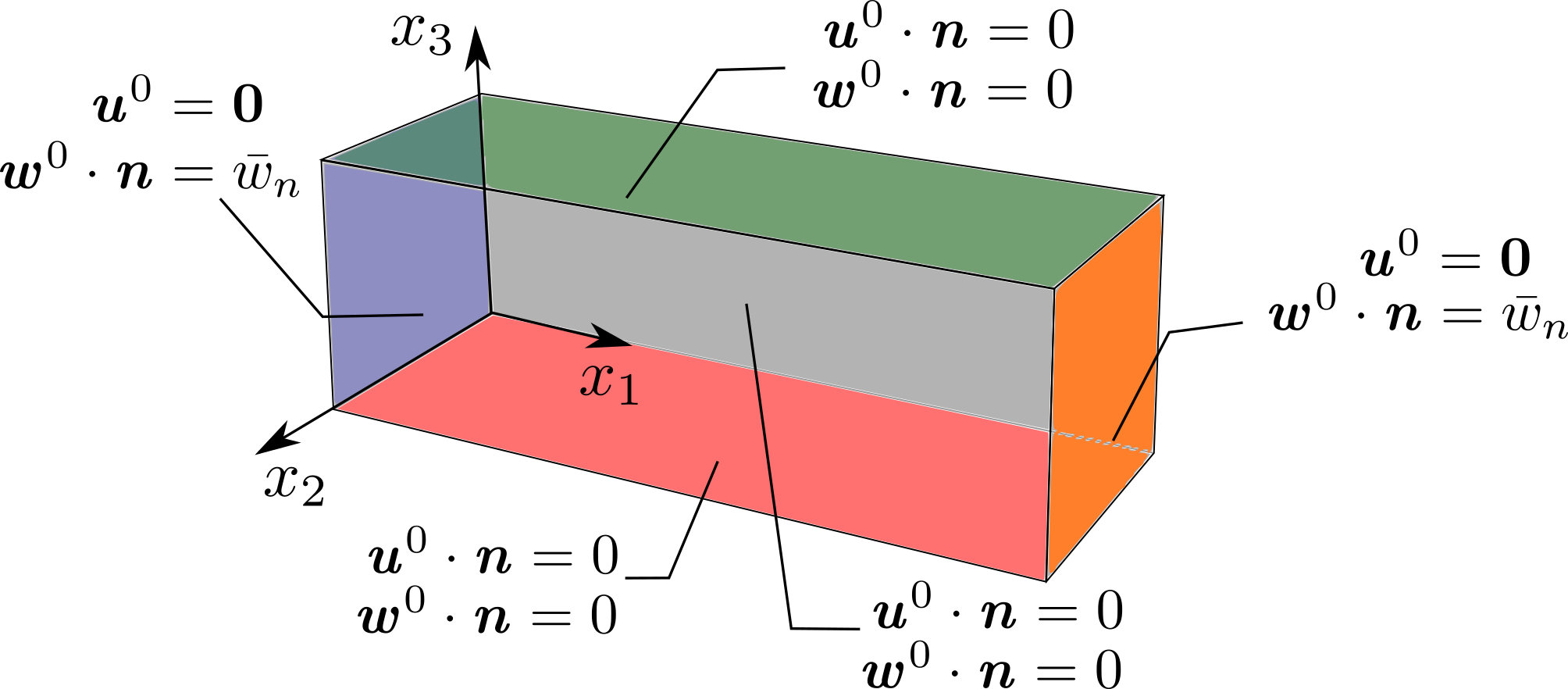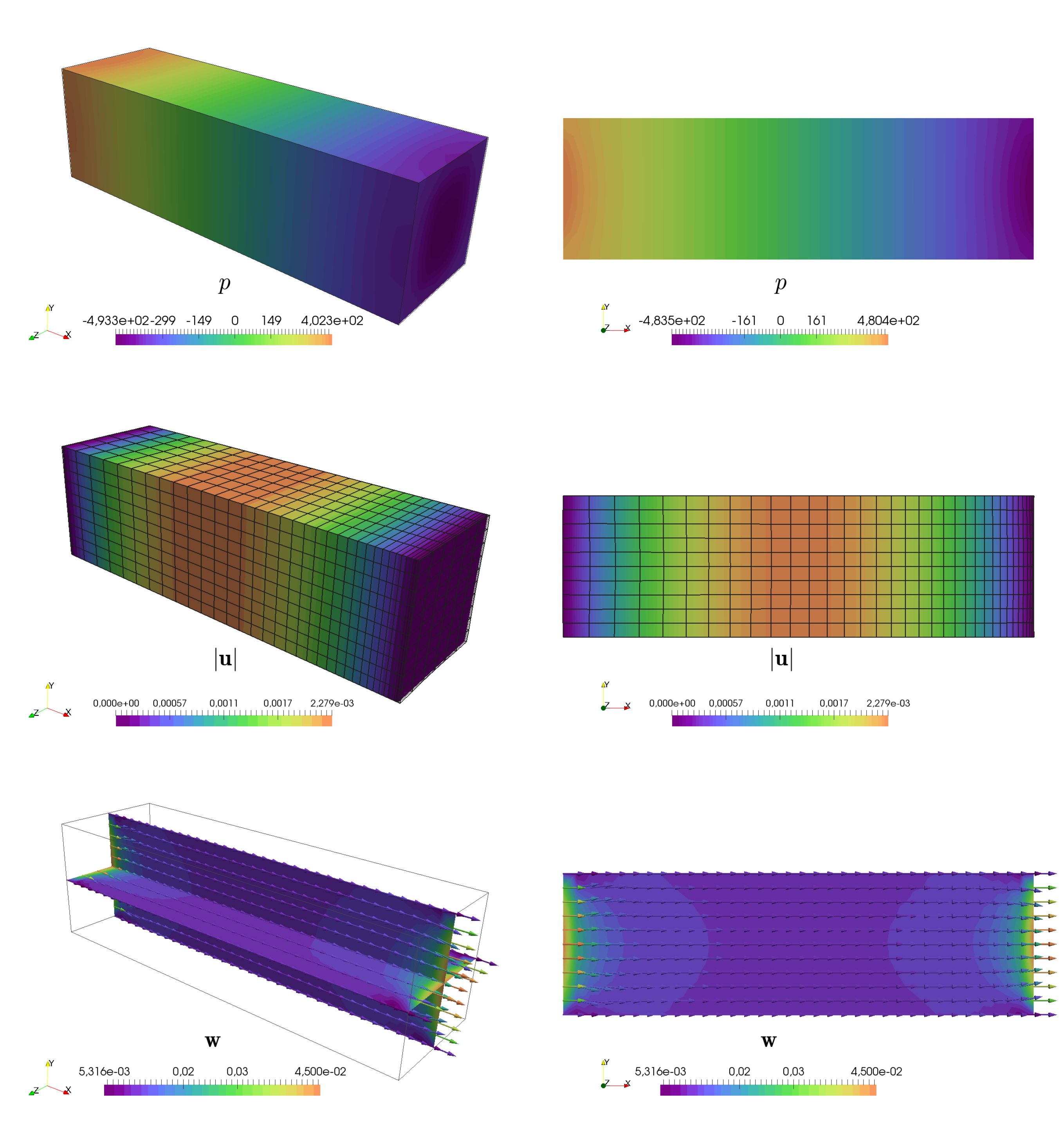Numerical simulation of viscous flow in deformable double porous media¶
Mathematical model¶
We consider a double porous medium which consists of an elastic solid matrix  perforated by
a system of channels filled with an incompressible fluid
perforated by
a system of channels filled with an incompressible fluid  with interface
with interface
 . These components are
arranged in a periodic lattice at both the micro- and mesoscopic level. Thus, the porous matrix at the mesoscopic level
can be generated medium can be generated by copies of the microscopic reference unit cell
. These components are
arranged in a periodic lattice at both the micro- and mesoscopic level. Thus, the porous matrix at the mesoscopic level
can be generated medium can be generated by copies of the microscopic reference unit cell  and, subsequently,
macroscopic body can be generated as alattice of the mesoscopic reference unit cell
and, subsequently,
macroscopic body can be generated as alattice of the mesoscopic reference unit cell  , see Fig. 1.
Two small scale parameters
, see Fig. 1.
Two small scale parameters  and
and  chracterize micro- and meso-porosities.
At the mesoscopic scale, the periodic structure is formed by fluid filled channels occupying domain Om_c^delta
and by domain
chracterize micro- and meso-porosities.
At the mesoscopic scale, the periodic structure is formed by fluid filled channels occupying domain Om_c^delta
and by domain  which is constituted by a microporous material.
In particular, domain
which is constituted by a microporous material.
In particular, domain  represents micro pores saturated by fluid,
whereas
represents micro pores saturated by fluid,
whereas  is the skeleton, see Fig. 1..
is the skeleton, see Fig. 1..
To summarize the decompositions,

The superscripts  and
and  denote the quantities oscillating within the heterogeneous
structure with the period equal to the size of the micro- and mesoscopic periodic unit. However, we drop the superscript
in following text to simplify the notation.
denote the quantities oscillating within the heterogeneous
structure with the period equal to the size of the micro- and mesoscopic periodic unit. However, we drop the superscript
in following text to simplify the notation.
Fig. 1 Macroscopic domain  and decomposition of microscopic domain
and decomposition of microscopic domain  and mesoscopic domain
and mesoscopic domain  .¶
.¶
The mechanical behavior of such a structure can be described using the two-level asymptotic homogenization method, (for more detailed explanaition we refer to [RohanTurjanicovaLukes2019]).
The mechanical properties of the deformable matrix are given by elasticity tensor  which satisfies
the usual symmetries.
which satisfies
the usual symmetries.
The fluid is characterized by viscosity  which is given by a piece-wise constant function,
which is given by a piece-wise constant function,
(1)¶
The scaling of the viscosity in micropores  is the standart consequence of the non-slip boundary
condition on he pore wall.
is the standart consequence of the non-slip boundary
condition on he pore wall.
The problem of the fluid flow in deformable media at microscopic level is given by the following
equilibrium equations and boundary conditions governing displacement of the solid  and both the fluid
pressure and velocity fields
and both the fluid
pressure and velocity fields  :
:
(2)¶
where  is the fluid stress,
is the fluid stress,  is the strain in the solid with components
is the strain in the solid with components  ,
,  denotes the volume forces in the solid or in the fluid, and
denotes the volume forces in the solid or in the fluid, and  is the surfacetraction stresses acting
on the solid part. The relative fluid velocity
is the surfacetraction stresses acting
on the solid part. The relative fluid velocity  in the fluid-filled pores
in the fluid-filled pores
 is defined whit use of a smooth extention
is defined whit use of a smooth extention  of the dislacement field
of the dislacement field  from solid
from solid  to whole domain
to whole domain  .
.
Two-level homogenization¶
Due to the double-porous nature of the medium, we performe two levels of homogenization.
The 1st-level of homogenization concerns the asymptotic analysis  related to the
fluid-structure interaction in microporous structure situated in
related to the
fluid-structure interaction in microporous structure situated in  .
We apply the standard homogenization techniques to the above problem. It
results in the limit model for
.
We apply the standard homogenization techniques to the above problem. It
results in the limit model for  , where
, where
 is the scale parameter relating the microscopic and macroscopic
length scales. The homogenization process leads to local microscopic problems,
defined within a reference periodic cell
is the scale parameter relating the microscopic and macroscopic
length scales. The homogenization process leads to local microscopic problems,
defined within a reference periodic cell  , and to the mesoscopic problem describing
the behavior of the homogenized matrix at the mesoscopic level. The mesoscopic
problem involves the homogenized material coefficients which are evaluated
using the solutions of the local problems. The 2nd-level of homogenization deals with upsacling from meso-
to macroscopic scale. It results in the limit model for
, and to the mesoscopic problem describing
the behavior of the homogenized matrix at the mesoscopic level. The mesoscopic
problem involves the homogenized material coefficients which are evaluated
using the solutions of the local problems. The 2nd-level of homogenization deals with upsacling from meso-
to macroscopic scale. It results in the limit model for
 and subsequently in the local mesoscopic problems on
a reference periodic cell
and subsequently in the local mesoscopic problems on
a reference periodic cell  , and in the derivation of the homogenized problem at macroscopic level.
Due to linearity of the problem, the microscopic, mesoscopic and macroscopic problems are decoupled.
, and in the derivation of the homogenized problem at macroscopic level.
Due to linearity of the problem, the microscopic, mesoscopic and macroscopic problems are decoupled.
The local microscopic responses are given by the following sub-problems which are solved within the periodic
reference cell  , see Fig. 1, that is decomposed similarly to the decomposition of
domain
, see Fig. 1, that is decomposed similarly to the decomposition of
domain  :
:
Find
 ,
,  such that for all
such that for all  for any
for any 
(3)¶![\int_{Y_s} \Db \eeby{\omegab^{ij} + \Pib^{ij}}: \eeby{\vb}\,\dV &= 0, \\
\int_{Y_{s}} \Db \eeby{\omegab^P}: \eeby{\vb}\,\dV &=
-{1\over \vert Y\vert}\int_{\Gamma_Y} \vb \cdot \nb^{[s]}\, \dS,](_images/math/501fd78cce0baa2482ab372b9f7c4c64d073531f.png)
where  .
.
Find
 ,
,  such that for all
such that for all  ,
,
 satisfying
satisfying
(4)¶
The microscopic sub-problems are solved with the periodic boundary conditions
and  is the interface between solid and fluid part of the cell
is the interface between solid and fluid part of the cell  .
.
With the characteristic responses obtained by solving local sub-problems,
the homogenized material coefficients  ,
,  ,
,  and
and  can be evaluated
using the following expressions:
can be evaluated
using the following expressions:
(5)¶![A_{ijkl} & = {1\over \vert Y\vert} \left[ \int_{Y_{s}} \Db \eeby{\omegab^{kl} + \Pib^{kl}}: \eebz{\omegab^{ij} + \Pib^{ij}}\,\dV\right],\\
B_{ij} & = \phi_f\delta_{ij}-{1\over \vert Y\vert} \left[\int_{Y_s} \Db \eeby{\omegab^{P}}:\eeby{\Pib^{ij}}\,\dV\right],\\
K_{ij} & = {1\over \vert Y\vert} \int_{Y_f} \nabla_y\psi^i:\nabla_y\psi^i\,\dV,\\
M & = {1\over \vert Y\vert} \left[\int_{Y_s} \Db \eeby{\omegab^{P}}:\eeby{\omegab^{P}} \,\dV \right].](_images/math/82cdd0f0a4d4180922137b8aec587c149822f60a.png)
Homogenization - 2nd level¶
At the 2st-level of homogenization, the asymptotic analysis  is related to the
interaction between the homogenized microporous matrix in
is related to the
interaction between the homogenized microporous matrix in  and fluid in channels
and fluid in channels  at mesoscopic level. By same upscaling procedure as in 1st level of homogenization, we obtain
local mesoscopic problems,
defined within a reference periodic cell
at mesoscopic level. By same upscaling procedure as in 1st level of homogenization, we obtain
local mesoscopic problems,
defined within a reference periodic cell  ,
where we enter the homogenized coefficients obtained by 1st level homogenization.
We also arrive to the global problem describing
the behavior of the homogenized matrix at the macroscopic level.
The homogenized material coefficients describing whichdescribe behavior at macroscopic level are evaluated using the
solutions of the local mesoscopic problems.Due to linearity of the problem, the
microscopic, mesoscopic and macroscopic problems are decoupled.
,
where we enter the homogenized coefficients obtained by 1st level homogenization.
We also arrive to the global problem describing
the behavior of the homogenized matrix at the macroscopic level.
The homogenized material coefficients describing whichdescribe behavior at macroscopic level are evaluated using the
solutions of the local mesoscopic problems.Due to linearity of the problem, the
microscopic, mesoscopic and macroscopic problems are decoupled.
The local mesoscopic responses are given by the following sub-problems which are solved within the periodic
reference cell  , see Fig. 1, that is decomposed similarly to the decomposition of
domain
, see Fig. 1, that is decomposed similarly to the decomposition of
domain  :
:
Find
 ,
,  such that for all
such that for all  for any
for any 
(6)¶![\int_{Z_m} \Ab \eebz{\omegab^{ij} + \Pib^{ij}}: \eebz{\vb}\,\dV &= 0, \\
\int_{Z_{m}} \Ab \eebz{\omegab^P}: \eebz{\vb}\,\dV - \int_{Z_m} \Bb: \eebz{\vb} \,\dV &=
-{1\over \vert Z\vert}\int_{\Gamma_z} \vb \cdot \nb^{[m]}\, \dS ,](_images/math/4c5b6c7d2556a8a0ef6ec1c4e16fc9a3da3d6e3d.png)
where  .
.
Find
 ,
,  such that for all
such that for all  satisfying
satisfying
(7)¶![\int_{Z_{m}} \nabla_z q \Kb \nabla_z \pi^k \,\dV &= -\int_{Z_{m}} \nabla_z q \Kb \nabla_z z_k , \\
\int_{Z_{m}} \nabla_z q \Kb \nabla_z \vphi^k \,\dV &= -{1\over \vert Z\vert}\int_{\Gamma_z} q \nb^{[c]}_k\, \dS .](_images/math/86379e63e9eecd1091fff46a106fb6462a275f13.png)
Find
 ,
,  such that for all
such that for all  ,
,
 satisfying
satisfying
(8)¶
The mesoscopic sub-problems are solved with the periodic boundary conditions
and  is the interface between
the matrix part
is the interface between
the matrix part  and canal
and canal  .
.
With the characteristic responses obtained by solving local sub-problems,
the homogenized material coefficients  ,
,  ,
,  ,
,  ,
,  , and
, and  can be evaluated
using the following expressions:
can be evaluated
using the following expressions:
(9)¶![\Acal_{ijkl} & = {1\over \vert Z\vert} \left[ \int_{Z_{m}} \left[\Ab \eebz{\omegab^{kl}
+ \Pib^{kl}}\right]: \eebz{\omegab^{ij} + \Pib^{ij}}\,\dV\right],\\
\Bcal_{ij} & = \phi_c\delta_ij+{1\over \vert Z\vert} \left[\int_{Z_m} \Bb: \eebz{\Pib^{ij}+\omegab^{ij}} \,\dV
- \int_{\Gamma_Z} \nb^{m}\cdot \omegab^{ij} \,\dV\right],\\
\Hcal_{ij} & = {1\over \vert Z\vert} \int_{Z_m} \nabla_z\vphi^j\cdot\Kb\nabla_z\vphi^i\,\dV,\\
\Kcal_{ij} & = {1\over \vert Z\vert} \int_{Z_m} \nabla_z(z_j+\pi^j)\cdot\Kb\nabla_z(z_i+\pi^i)\,\dV,\\
\Pcal_{ij} &= \phi_c\delta_{ij}-{1\over \vert Z\vert}\int_{\Gamma_Z} \pi^i n_j^{m}\, \dS
=\phi_c\delta_{ij}+{1\over \vert Z\vert} \int_{Z_m} \nabla_z\vphi^j\cdot\Kb\nabla_z\vphi^i\,\dV,\\
\Scal_{{ijkl}} &={1\over \vert Z\vert}\left[2\eta\int_{Z_c}\eebz{\psib^{kl}+\Pib^{kl}}:\eebz{\psib^{ij}
+\Pib^{ij}}\,\dV-\int_{Z_c} \hat{\vphi}^{kl}\nabla_z\cdot\Pib^{ij}\, \dV\right],\\
\Mcal &={1\over \vert Z\vert}\left[\int_{Z_m}M\,\dV+ \int_{Z_m} \Bb: \eebz{\omegab^{P}} \,\dV
- \int_{\Gamma_Z} \nb^{c}\cdot \omegab^{P} \,\dV\right].](_images/math/2e0b22b7957b4d8b46dc308753ee2046ea292ae1.png)
All coefficients are symmetric with respect to indices related to strain and strain rate tensors, i.e.  .
.
The global macroscopic problem is defined in terms of the homogenized
coefficients as: Find the macroscopic displacements  and
and
 such that for all
such that for all  and
and 
(10)¶![\int_{\Omega} [\Acalb \eebx{\ub^0} - p^0 \Bcalb^T]: \eebx{\vb^0}\,\dV - \int_{\Omega}\vb^0\cdot\Pcalb^T(\nabla_xp^0-\fb^f) &
- \int_\Omega \vb^0 \Hcalb^T\wb^0\,\dV +\int_{\partial_\sigma\Omega}\bar{\phi}_c\bar{p^0}\nb\cdot\vb^0\,\dV\\
&= \int_{\Omega} \fb^{blk}\cdot\vb^0 \,\dV+\int_{\partial_\sigma\Omega}\bar{\phi}_m\bar{\phi}_s\gb\cdot\vb^0\,\dV,
+ \int_{\Omega} f \cdot \vb \dV,\\
\int_{\Omega} q^0(\Bcalb:\eebx{\dot\ub^0} + \dot p^0 \Mcal) \dV +\int_\Omega (\Kcalb(\nabla_xp^0-\fb^f)-\Pcalb\wb^0)\,\dV
&= -\int_{\partial_w\Omega} q^0 (\bar\phi_m\bar\phi_f\bar w_n^{mic}+\bar\phi_c\bar w_n^{mes}) \,\dV,\\
\int_{\Omega}\eebx{\thetab^0}:\Scalb\eebx{\wb^0+\dot\ub^0}\,\dV+\int_\Omega\thetab^0\cdot\Pcalb(\nabla_xp^0-\fb^f)\,\dV
+\int_\Omega\Hcalb\wb^0 &=\int_{\partial_p\Omega}\bar\phi_c\bar p^0\nb\cdot\thetab^0\,\dV.](_images/math/6995151c0e494202c656629b8654c806efca20c2.png)
The Dirichlet boundary conditions prescribed for  and
and  can be imposed,
can be imposed,
(11)¶
The pressure  fulfils zero-means conditions
fulfils zero-means conditions  in the whole domain
in the whole domain  .
.
The complementary Neumann-type boundary condition are specfied as follows
(12)¶
For the purpose of this example, we simplify the problem (13). We consider only steady
state of the problem and omitt all volume froces
 and
and  and surface tractions
and surface tractions  . Also we will consider
closed micropores on the whole boundary
. Also we will consider
closed micropores on the whole boundary  , i.e.
, i.e.  .
The problem (10) becomes:
Find the macroscopic displacements
.
The problem (10) becomes:
Find the macroscopic displacements  and
and
 such that for all
such that for all  and
and 
(13)¶![\int_{\Omega} [\Acalb \eebx{\ub^0} - p^0 \Bcalb^T]: \eebx{\vb^0}\,\dV - \int_{\Omega}\vb^0\cdot\Pcalb^T\nabla_xp^0
- \int_\Omega \vb^0 \Hcalb^T\wb^0\,\dV&= 0\\
\int_\Omega (\Kcalb\nabla_xp^0-\Pcalb\wb^0)\,\dV
&= -\int_{\partial_w\Omega} q^0 \bar\phi_c\bar w_n^{mes} \,\dV,\\
\int_{\Omega}\eebx{\thetab^0}:\Scalb\eebx{\wb^0}\,\dV+\int_\Omega\thetab^0\cdot\Pcalb\nabla_xp^0\,\dV+\int_\Omega\Hcalb\wb^0 &=0.](_images/math/922dca04b63fc29a77b5465d7944b1954ac3ff2b.png)
Numerical simulation¶

Fig. 2 Left - geometric representation of microscopic domain; Right - geometric representation of mesoscopic domain¶
To run the numerical simulation, download the archive, unpack it in the main SfePy directory and type:
./simple.py example_perfusion_BDB-1/perf_BDB_mac.py
This invoke the simply.py script which calculates the macroscopic
problem (13) and calls the homogenization engine that solves the
local subproblems for given parameter  , viscosity
, viscosity  and elastic tensor
and elastic tensor  . First, it solves subproblems (3) and (4)
on microscopic cell
. First, it solves subproblems (3) and (4)
on microscopic cell  (see Fig. 2 left) and
evaluates the homogenized
coefficients (5). Then, using solution from previous step, it solves subproblems
(6)–(8) on mesoscopic cell
(see Fig. 2 left) and
evaluates the homogenized
coefficients (5). Then, using solution from previous step, it solves subproblems
(6)–(8) on mesoscopic cell  (see Fig. 2 right)
and evaluates the homogenized coefficients (9). See [CimrmanLukesRohan2019] for more details related
to the SfePy homogenization engine.
(see Fig. 2 right)
and evaluates the homogenized coefficients (9). See [CimrmanLukesRohan2019] for more details related
to the SfePy homogenization engine.
The macroscopic sample is fixed on both left and right side, so that no displacements are
allowed, see Fig. 3. The defromation is induced due to the flow through porous matrix, as the
responce to the prescribed velocity  , see (13).
, see (13).

Fig. 3 Boundary conditions applied at the macroscopic level¶
The resultin macroscopic pressure field  , displacement
, displacement  and the velocity field
and the velocity field  are depicted in
Fig. 4, where deformation is visualised by deformed wireframe.
are depicted in
Fig. 4, where deformation is visualised by deformed wireframe.

Fig. 4 Macroscopic sample and the resulting macroscopic fields: left - 3D view of pressure
 , displacement
, displacement  and velocity field
and velocity field  ; right - pressure
; right - pressure
 , displacement
, displacement  and velocity field
and velocity field  in
in  -crosssection.¶
-crosssection.¶
References¶
- RohanTurjanicovaLukes2019
Rohan E., Turjanicová J., Lukeš V. The Biot–Darcy–Brinkman model of flow in deformable double porous media; homogenization and numerical modelling. Computers and Mathematics with applications, 78(9):3044-3066, 2019, DOI:10.1016/j.camwa.2019.04.004
- CimrmanLukesRohan2019
Cimrman R., Lukes V., Rohan E. Multiscale finite element calculations in Python using SfePy. Advances in Computational Mathematics, 45(4):1897-1921, 2019, DOI:10.1007/s10444-019-09666-0